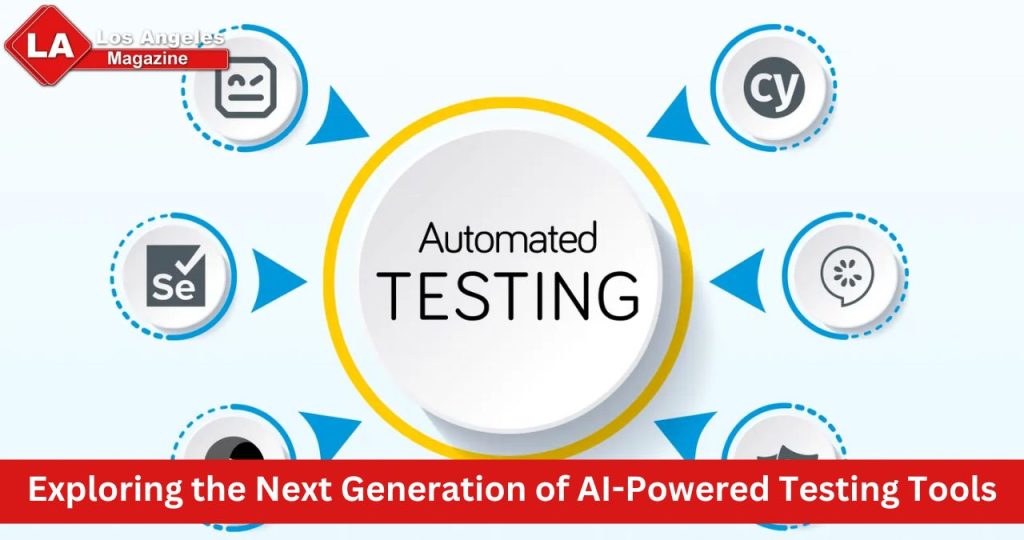The testing need grows in sync with the increase of software development lifecycle becoming complex as technology evolves. Now software applications are not simply static systems but are highly dynamic, intricate platforms. As such, their demands and expectations for better performance, security, and usability at a higher scale and level over increasingly more varieties of devices and environments grow accordingly. Although effective, the traditional approach of testing methods is more resource-intensive and time-consuming with human errors, so they are not as preferable for modern software development tasks.
AI testing tools represent the next generation of solution providers, which promise a revolution in ensuring software quality. These tools apply the powers of artificial intelligence and machine learning to automate testing, giving smarter, faster, and more accurate testing capacities. AI testing tools can predict likely issues through learning from earlier tests and adapting to changing software in real-time, ensuring better test coverage and early detection of bugs in development cycles.
Software development teams are now exploring fresh new avenues for collaboration and making it possible to produce quicker software with high quality because there is a shift away from labor-intensive manual testing toward intelligent, automated systems. As the demand for faster delivery and continuous integration increases, AI testing tools continue to become an inevitable and integral part of the overall development process.
We will go over the main characteristics and advantages of AI testing tools in this blog as well as how they are changing the software testing environment and influencing application development going forward. Let’s explore AI-powered testing and discover how these instruments are establishing new benchmarks for quality control.
What is an AI Testing Tool?
An artificial intelligence testing tool is a piece of software that automates different software testing steps using machine learning and AI algorithms. The goal of these tools is to replicate real-world user behavior identify bugs and analyze code accurately and efficiently—all of which were previously impossible with manual testing.
Unlike conventional testing where a tester would need to create test scripts, execute the same, and then produce reports, AI testing is such that a tool autonomously generates test cases and runs them against the target. The AI continuously learns and adjusts from its previous experiences, ensuring full coverage while improving feedback cycles.
Key Features of AI Testing Tools
AI testing tools introduce many sophisticated capabilities to the process of testing software. The entire software testing process has been smartened up, accelerated, and made reliable by it. AI testing tools apply artificial intelligence and machine learning to define conventional testing ways, and so the entire team focuses on providing top-quality software at high velocity. Below are some main features which define AI testing tools:
Autonomous Test Creation and Execution
The key feature of AI test tools is their ability to automatically create test cases regarding the software’s behavior patterns and testing patterns. These tests scan through the application’s code, simulate the actions to be performed by the end-user, and generate the number of test cases with the aim of covering diverse scenarios in detail. The tests get executed automatically after creation by an AI system, ensuring tests are efficient as well as exhaustive.
Real-Time Adaptation
The testing approach will also evolve with the evolution of applications. AI testing tools can dynamically adjust to changes in software. Whether it is a new feature, code updates, or changes in the user interface, the AI system can quickly adapt and change the test cases to make sure the application is well-tested. This adaptability makes it easier to test modern software that is subject to constant iterations and updates.
Intelligent Test Coverage and Analysis
AI-powered testing tools use machine learning to detect the critical areas of the software that need more attention. Based on the analysis of previous testing data, these tools prioritize tests based on risk factors, usage frequency, and other criteria. It ensures that the most critical parts of the application are more stringently tested to find bugs before they reach end-users.
Predictive Bug Detection
Predictive bug detection is one of the most exciting capabilities of AI testing tools. This allows AI tools to look into historical data and understand trends and patterns that could point to where defects might arise. Developers and testers can, therefore, take proactive steps in addressing the issues at the right time, before it becomes a problem and requires much cost and time to fix later in the development cycle.
Cross-Platform Testing
Testing is required on various platforms, devices, and browsers today to ensure applications work well for all users. AI testing tools make this easy because they run tests automatically on multiple configurations. Be it different operating systems, web browsers, or mobile devices, AI tools can scale and execute tests across multiple environments at once, giving a complete review of the software’s compatibility.
Benefits of Using an AI Testing Tool
The way quality assurance is approached has changed dramatically as a result of the software development lifecycles’ adoption of AI testing tools. Compared to manual testing methods these tools which make use of machine learning and artificial intelligence algorithms have many advantages that improve scalability accuracy and efficiency. The main advantages of utilizing an AI testing tool are listed below:
Faster Time-to-Market: Speed is a critical aspect in today’s software development environment. With the aid of AI testing tools, development teams can reduce the testing phase to a great extent. AI tools enable teams to deliver software updates faster by automating repetitive tasks, executing tests faster, and providing quicker feedback. Such a fast time-to-market can give a significant competitive advantage, keeping companies ahead of the curve.
Enhanced Precision and Quality: Manual testing is based on human judgment, which in turn leads to human mistakes, and therefore, not all bugs are detected, along with incomplete test coverage. AI testing tool eliminates this problem as tests execute with precision and consistency and can run tests across an enormous scope that a manual tester cannot possibly cover while testing. This results in higher-quality software with far fewer bugs that reach the production environment.
Cost Efficiency: Although the initial investment in AI testing tools seems pretty high, they provide long-term cost savings through the reduction of extensive manual testing and the amount of time it takes to identify and fix issues. Automated testing also saves on the cost of hiring large QA teams, and the company can use its resources more efficiently. Early detection of issues also prevents costly fixes after the software has been deployed.
Scalability and Flexibility: Applications introduce increased test complexity. AI testing tools are designed to scale as the application grows and accepts an increasing number of tests due to new features and platforms entering the system. Such scalability makes AI tools the go-to choice for large complex systems, such as web applications, mobile applications, or hybrid solutions.
Continuous Testing in Agile and DevOps Environments: The Agile and DevOps movement has, therefore led to the demand for constant testing. In this methodology, feedback is provided continuously throughout the development process and not when the product is ready to be released. AI-based testing tools fit very seamlessly into CI/CD pipelines; this means that software, at every step of the development process, is under test. It fosters a culture of continuous quality improvement and allows issues to be corrected in real-time.
The Future of AI Testing Tools
As AI technology continues to advance, the capabilities of AI testing tools will only improve. Future developments may include:
Smarter AI Models: As AI models become more sophisticated, they can handle even more complex testing scenarios, such as testing AI-driven applications or integrating with other emerging technologies like IoT and blockchain.
Self-Healing Testing: The development of AI testing tools that can heal themselves is an intriguing prospect. When software updates these tools will automatically detect and correct malfunctioning test scripts guaranteeing that tests stay current without the need for human intervention.
More Accessible Testing: As AI testing technologies advance they will become easier to use enabling non-technical users to compose and execute tests with little difficulty. Quality assurance will become more accessible to all developers as a result of this democratization of testing.
How LambdaTest Leverages Test AI to Revolutionize Software Testing
LambdaTest is a cloud-based cross-browser testing tool created to make website testing easier and smoother across many devices. With its comprehensive testing capabilities, developers can ensure that their websites are optimized and offer a consistent user experience for all users, irrespective of the browser or device they’re using.
Developers and QA experts may use LambdaTest, an AI-powered platform for test orchestration and execution, to run automated tests on more than 3000 environments, including real-world scenarios.
A wide range of tools for testing web apps across different browsers operating systems and devices are available from the cloud-based platform LambdaTest. It easily combines with Test AI a LambdaTest feature that uses artificial intelligence to improve automated testing accuracy and efficiency.
AI-driven testing combined with LambdaTests cross-browser testing features can greatly enhance developers’ and testers’ testing processes and guarantee better applications that function well in a variety of settings. This section will examine how LambdaTest uses Test AI to improve testing expedite workflows and deliver quicker feedback for contemporary software development.
Benefits of Using LambdaTest’s Test AI
Software testing can be made more efficient accuracy can be increased and development teams can produce high-quality applications more quickly with the help of LambdaTests Test AI. Software testing is revolutionized by LambdaTests AI-driven capabilities which guarantee more productive and successful testing cycles. The main advantages of utilizing Test AI on the LambdaTest platform are listed below:
Improved Test Efficiency and Speed: Test AI speeds up testing and lowers the time it takes to find bugs by automating the development execution and analysis of test cases. Development teams can work more quickly and react to user feedback more quickly thanks to this increased speed which is particularly important in agile and DevOps environments. .
Higher Test Coverage: Test AI makes sure that a wider range of test scenarios are covered including edge cases that might be missed during manual testing by using AI-driven test case generation and parallel test execution. As a result, there is a greater chance of identifying important problems before they affect users and more thorough test coverage.
Cost Reduction: Test AI lowers labor costs by eliminating the need for large QA teams by automating many of the tasks involved in the testing process. Faster bug and issue detection also reduces the need for post-release fixes which can be much more costly and time-consuming.
Scalability for Growing Applications: Test AI from LambdaTest easily expands to support expanding applications whether those applications involve more user features or intricate integrations. Both small applications and enterprise-level software systems benefit greatly from their capacity to manage high test volumes concurrently across various platforms.
Conclusion:
The software development industry is at a turning point with the emergence of AI testing tools which provide a revolutionary approach to quality assurance that surpasses the capabilities of conventional testing techniques. There has never been a greater need for quicker more dependable and more effective testing as development cycles shorten and applications get more complex. By automating crucial steps in the testing process such as creating test cases executing them and analyzing them AI testing tools directly address these needs.
These tools use artificial intelligence and machine learning to speed up testing while also improving software quality lowering costs and increasing accuracy. The efficiency and flexibility offered by AI tools surpass that of manual testing due to its capacity to learn from past tests and adjust to modifications in the application. They let teams easily scale their testing efforts conduct thorough testing on various platforms and environments and find problems before they become expensive ones. Additionally incorporating AI testing tools into CI/CD pipelines encourages continuous testing guaranteeing that quality assurance is a continuous and smooth component of the development process.
AI testing tools have enormous potential for the future. These tools will get even smarter as AI models develop handling more complicated testing scenarios and accurately predicting possible problems. The capabilities of AI-powered testing will be further enhanced by the introduction of self-healing tests more user-friendly interfaces for non-technical users and closer integration with cutting-edge technologies like blockchain and the Internet of Things.
Using AI testing tools has become essential for companies looking to remain competitive in a market where software must be delivered fast and with few errors. These days teams of all sizes can benefit from these tools due to their scalability and accessibility which no longer limit them to large enterprises. Businesses can enhance user experience speed up development cycles cut expenses and improve product quality by adopting AI-driven quality assurance.



